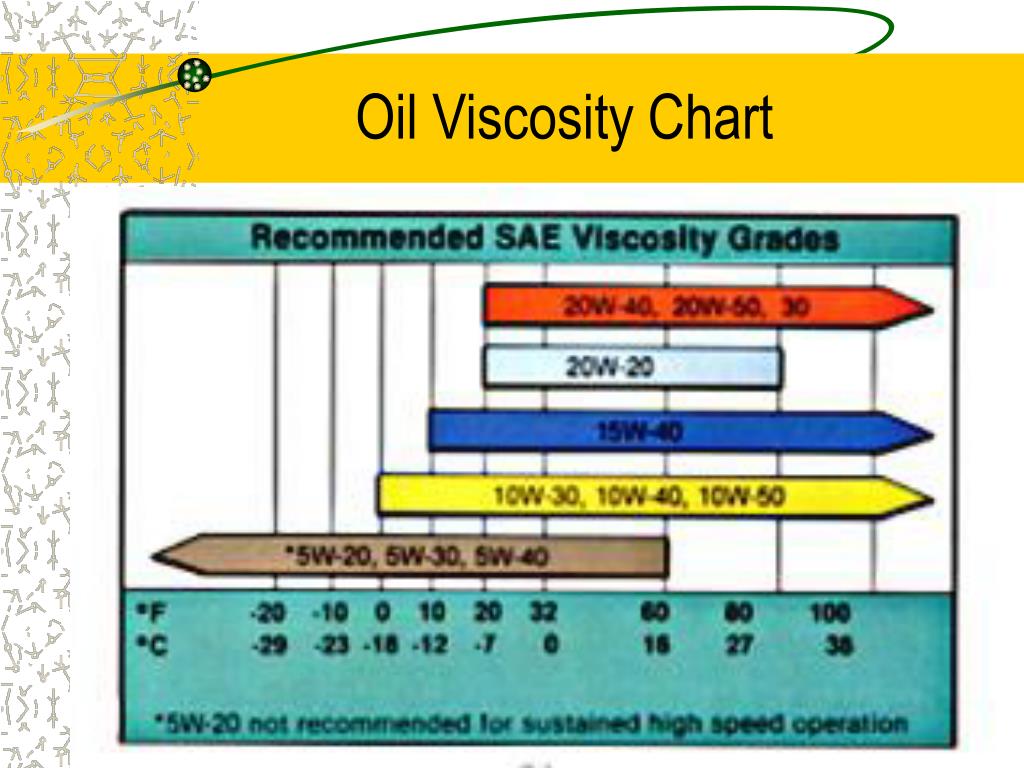
#OIL VISCOSITY CHART MANUAL#
If the Owner’s Manual employs a graphical depiction of oil viscosity vs an ambient temperature range, inclusion of any qualifier word, “preferred” for example, associated with the oil viscosity is considered to introduce ambiguity into the instruction, and disqualifies the use of GF-4 engine oil in test vehicles. If the API starburst logo is used in the owner’s manual in lieu of reference to GF-4, the manufacturer should include a brief explanation of its meaning. Owner’s Manual Language The manufacturer provides instructions in the Owner’s Manual that clearly and unambiguously identify that GF-4 engine oil (identified by the presence of the American Petroleum Institute (API) “Starburst” logo) of a specific viscosity grade ( 5W20, 5W30, 10W30) is to be used in the vehicle’s engine under normal ambient temperature and driving conditions. Or it can also very likely be a liability.ġ. I'm not trying to convince you to change oils - depending on your climate, the US factory recommended oil might actually be optimal. "Just use what Toyota recommends" - we're literally talking about what Toyota recommends when CAFE isn't in the equation. "It gets hot as hell in Australia!" - not any hotter than it does in Phoenix, genius. Makes you wonder.Īnd again - I can predict the typical responses to this. But the engines are nearly identical in terms of bearings and clearances.

This is on a car with low production (making for a small CAFE hit) that has a gas guzzler tax. When I traded my 5.0 for a GT350 with a 5.2, it wasn't lost on me that the oil spec changed to 5W50. Guess what they recommend in Australia? 5W30. I'm a Mustang owner, and it seemed odd to me that Ford recommended 5W20 in the high-revving, 430hp 5.0. Ford has taken to recommending lighter and lighter oils as well. Here's what the Australian owner's manual recommends:Ĭompare and contrast to the US owner's manual, which exclusively recommends the same 0W-20 as the 2016+ Taco:Īs I mentioned before, this is not exclusive to Toyota.

Helpfully, all RC 350's are built in Japan, so they should be very similar aside from one has the wheel on the wrong side. But it's largely the same engine.įor instance, the Lexus RC 350 uses the 2GR-FKS in both Australia and the US. But it is offered in lots of cars - likely with different cams, intake, and exhaust manifold if I were to guess. The 2GR-FKS isn't offered (to my knowledge) in any trucks anywhere else in the world, making comparisons difficult. Now, are there differences between the 1st gen 1GR-FE delivered in AU and elsewhere and the one we get in our 05-15 trucks? Very likely, but I'd bet anything that the bearings and clearances are the same, which is what really matters for oil pressure and such.įor you 2016+ owners, it's much the same story only Toyota now recommends 0W-20. I also peeked at the owners manual for the FJ Cruiser in AU with the 1GR-FE, and it had the exact same chart as the Hilux. But it also gets hot in Arizona, and note that the chart specifies a range of temperatures from -20F all the way up to 100F - exact same range as on the US chart!Ĭontrast that to the US manual for the Tacoma with 1GR-FE: Obviously, it gets pretty hot in Australia. This, for example, is from the 2014 Toyota Hilux in Australia: It's malarkey.Īs proof, you need to look no further than Toyota's owners manual for vehicles with the 1GR-FE engine outside of the US. People will tell you that it's because "modern engines have tighter tolerances" and plenty of other things that other people have told them.


Toyota isn't alone, as I have noticed Ford and Chevrolet doing the same thing. This seems to have gone out the window in recent years and by all accounts, CAFE (Corporate Average Fuel Economy) requirements in the US are largely to blame. All of the cars that I owned that were made in the 90's or earlier would specify more than one oil grade.
#OIL VISCOSITY CHART MANUALS#
I'm old enough to remember when owner's manuals used to specify multiple SAE oil grades depending on ambient temps. This got me thinking - what kind of oil is best for my engine rather than best for the warranty? It's been five years since I bought my 2014 V6, so now I am the powertrain warranty.


 0 kommentar(er)
0 kommentar(er)
